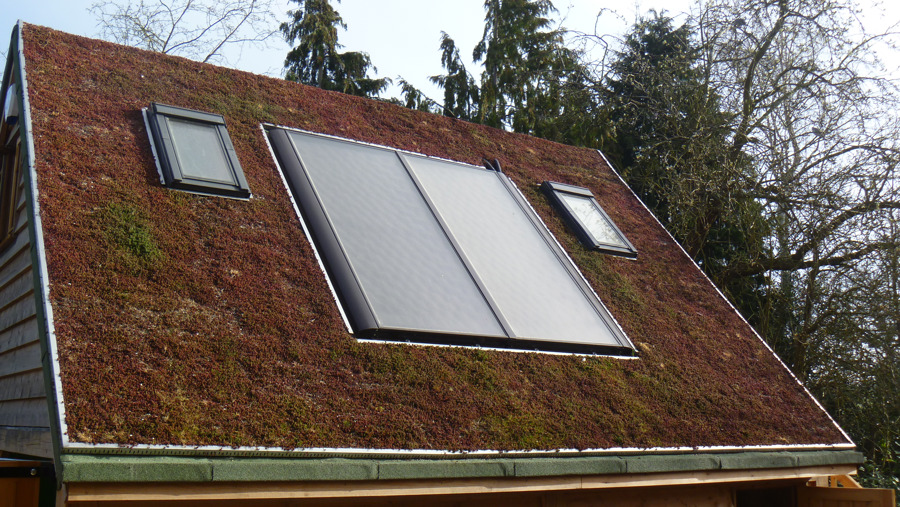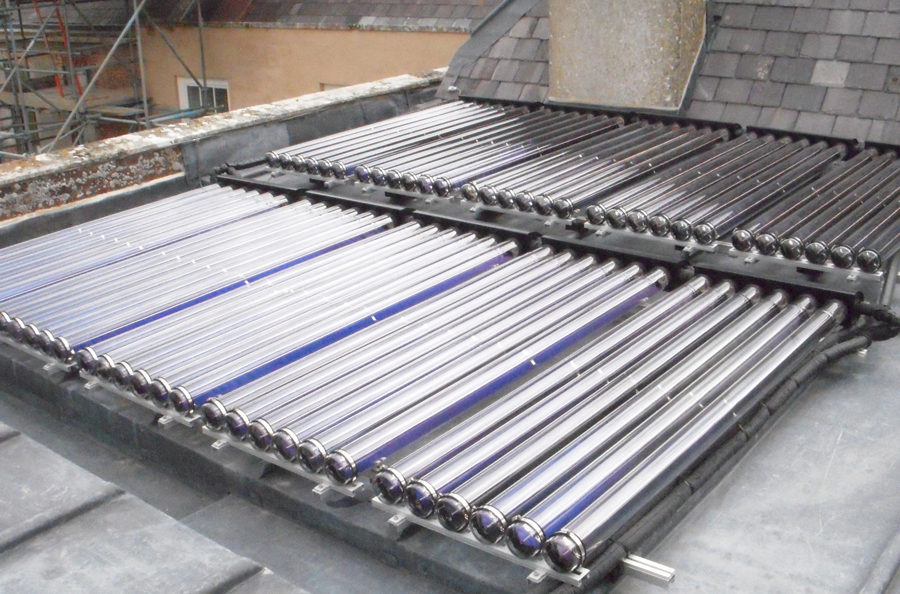
Solar Thermal
What is Solar Thermal?
A solar thermal system consists of a set of solar panels, normally mounted on the roof, that are used to heat a hot water tank. The panels are heated during the day by sun. A fluid is pumped through the panels to transfer the heat to the fluid. The fluid then flows through a coil in the tank where the heat is transferred to the water. The system consists of a set of panels, a pump and controller and a suitable hot water tank.
How does solar thermal work?

Solar panels in full sun are designed to absorb as much heat as possible and unless the fluid is passing through them continuously will reach temperatures well in excess of boiling point. On the other hand on a cold winter night the panels will drop to well below freezing point. Therefore the heat transfer fluid pumped around the system must be an antifreeze to prevent damage in the winter, and the pump must be controlled to extract the heat from the panels fast enough to stop the system overheating. Over-heating could be very dangerous if it caused the pipework or tank to fail, and is likely to damage the antifreeze.
There are two types of solar water heating panels:
- evacuated tubes – a bank of glass tubes mounted on the roof
- flat plate collectors, which can be fixed on the roof or integrated into the roof
Both of them are liquid cooled to transfer the heat to a hot water system. Evacuated tubes are more expensive and more efficient, especially in lower light conditions.
It is important to choose the number of panels to match the heating and hot water requirements of the property. Normally it is best to size the system to cover only the hot water requirements of the house, though it is possible to have a larger array of solar panels to contribute to the space heating or to a swimming pool.
The amount of heat delivered by a solar thermal system varies greatly over the course of the day, from nothing at night to perhaps a great deal in the middle of the day. The more significant variation is over the course of the year. In the winter the days are short and often cloudy and there will be many days when no useful energy is delivered at all. On the other hand in the summer there will be days when a solar thermal system will provide all the hot water you need. On average about ¾ of the benefit is delivered between April and September.

Because of this, a solar thermal system sized to make a worthwhile contribution to your heating in the winter means that it will be hugely oversized in the summer when, unless you have a swimming pool, you have no need for the heat. Most solar thermal systems, therefore, are designed to contribute only to the domestic hot water consumption, which is much more uniform through the year. In all cases it is essential that the system is designed by a competent designer to be safe in all circumstances: allowing a hot water tank to boil would be extremely dangerous. But beyond simple safety, a good system should be designed and operated to ‘dump’ excess heat when there is no load, during a summer holiday for example, to avoid overheating panels and heat transfer fluids. If that happens the repairs could be expensive.
Likely costs of Solar Thermal
The cost of installing a solar water heating system of this sort is likely to be in the range £4,000 – £6,000. With savings of about £100 per year a solar thermal system for hot water for a domestic house is not cost justifiable in the UK. You would be installing one to save CO2 emissions.
You are not likely to need planning permission for domestic solar thermal systems below a certain size and mounted on the roof of the house. However you should check with your local planning authority, especially if you live in a conservation area or National Park.
Maintenance is normally very little provided you make sure that the system does not overheat during a spell of hot weather when there is no or low demand – during a holiday for example. If that happens it may be necessary to have a service engineer flush and clean the system internally and replace the heat transfer fluid (anti-freeze).